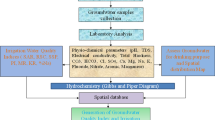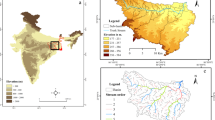Abstract
The rapid rise in population and industrialization has led to increase in consumption of the groundwater resources for drinking, agricultural and industrial purposes. The main objective of this study is to develop a groundwater recharge potential zone map and recommend sites for constructing artificial recharge structures in the Hamirpur district of northern India using Multi-Influencing Factor (MIF) and Weighted Overlay Index (WOI) techniques based on geographic information system. The groundwater potential zone map was developed by overlaying seven thematic maps, viz. soil texture, slope, land use/land cover, geology, drainage density, lineament density, and geomorphology, and giving appropriate weightage to each significant parameter with respect to its influence on groundwater. The results indicate that in the study area, the groundwater recharge potential was found to be very high in 0.6%, high in 18%, moderate in 72%, poor in 9% and very poor in 0.4% of the total area. Based on the developed groundwater potential zone map, sites for artificial recharge structures were recommended to replenish groundwater in the study area. The findings can be helpful in efficiently planning and managing the groundwater resource development.












Similar content being viewed by others
References
Acharya T, Kumbhakar S, Prasad R, Mondal S, Biswas A (2019) Delineation of potential groundwater recharge zones in the coastal area of north-eastern India using geoinformatics. Sustain Water Resour Manag 5(2):533–540
Agarwal R, Garg PK (2016) Remote sensing and GIS based groundwater potential and recharge zones mapping using multi-criteria decision making technique. Water Resour Manag 30(1):243–260
Andualem TG, Demeke GG (2019) Groundwater potential assessment using GIS and remote sensing: a case study of Guna tana landscape, upper blue Nile Basin, Ethiopia. J Hydrol Reg Stud 24:100610
Arya S, Subramani T, Karunanidhi D (2020) Delineation of groundwater potential zones and recommendation of artificial recharge structures for augmentation of groundwater resources in Vattamalaikarai Basin, South India. Environ Earth Sci 79(5):1–13
Asano T (ed) (2016) Artificial recharge of groundwater. Elsevier, Amsterdam
Bhattacharya AK (2010) Artificial ground water recharge with a special reference to India. Artif Gr Water Recharg 4(2):214–221
Central Ground Water Board (2019) Ground water yearbook Himachal Pradesh (2017–2018). Ministry of Water Resources River Development and Ganga Rejuvenation, Government of India
Dar IA, Sankar K, Dar MA (2010) Remote sensing technology and geographic information system modeling: an integrated approach towards the mapping of groundwater potential zones in Hardrock terrain, Mamundiyar Basin. J Hydrol 394(3–4):285–295
Elmahdy SI, Mohamed MM (2014) Groundwater potential modelling using remote sensing and GIS: a case study of the Al Dhaid area, United Arab Emirates. Geocarto Int 29(4):433–450
Fashae OA, Tijani MN, Talabi AO, Adedeji OI (2014) Delineation of groundwater potential zones in the crystalline basement terrain of SW-Nigeria: an integrated GIS and remote sensing approach. Appl Water Sci 4(1):19–38
Ghorbani Nejad S, Falah F, Daneshfar M, Haghizadeh A, Rahmati O (2017) Delineation of groundwater potential zones using remote sensing and GIS-based data-driven models. Geocarto Int 32(2):167–187
Gumma MK, Pavelic P (2013) Mapping of groundwater potential zones across Ghana using remote sensing, geographic information systems, and spatial modeling. Environ Monit Assess 185(4):3561–3579
Gupta M, Srivastava PK (2010) Integrating GIS and remote sensing for identification of groundwater potential zones in the hilly terrain of Pavagarh, Gujarat, India. Water Int 35(2):233–245
Jat MK, Khare D, Garg PK (2009) Urbanization and its impact on groundwater: a remote sensing and GIS-based assessment approach. Environmentalist 29(1):17
Javed A, Wani MH (2009) Delineation of groundwater potential zones in Kakund watershed, Eastern Rajasthan, using remote sensing and GIS techniques. J Geol Soc India 73(2):229–236
Kadam AK, Umrikar BN, Sankhua RN (2020) Assessment of recharge potential zones for groundwater development and management using geospatial and MCDA technologies in semiarid region of Western India. SN Appl Sci 2(2):1–11
Kumar P, Herath S, Avtar R, Takeuchi K (2016) Mapping of groundwater potential zones in Killinochi area, Sri Lanka, using GIS and remote sensing techniques. Sustain Water Resour Manag 2(4):419–430
Li P, Wu J, Qian H, Zhang Y, Yang N, Jing L, Yu P (2016) Hydro-geochemical characterization of groundwater in and around a wastewater irrigated forest in the southeastern edge of the Teng-ger Desert, Northwest China. Expo Health 8(3):331–348
Machiwal D, Jha MK, Mal BC (2011) Assessment of groundwater potential in a semi-arid region of India using remote sensing, GIS and MCDM techniques. Water Resour Manag 25(5):1359–1386
Magesh NS, Chandrasekar N, Soundranayagam JP (2012) Delineation of groundwater potential zones in Theni district, Tamil Nadu, using remote sensing. GIS MIF Tech Geosci Front 3(2):189–196
Mohammadzadeh-Habili J, Khalili D (2020) Assessment of artificial recharge dams and improvement of their groundwater-recharge capacity. J Hydrol Eng 25(5):04020011
Mukherjee P, Singh CK, Mukherjee S (2012) Delineation of groundwater potential zones in arid region of India—a remote sensing and GIS approach. Water Resour Manag 26(9):2643–2672
Nag SK, Ghosh P (2013) Delineation of groundwater potential zone in Chhatna Block, Bankura District, West Bengal, India using remote sensing and GIS techniques. Environ Earth Sci 70(5):2115–2127
Navane VS, Sahoo SN (2017) A review of integrated RS and GIS technique in groundwater potential zone mapping. In: Proc. 22nd International Conference on Hydraulics, Water Resources and Coastal Engineering, Ahmedabad, India, 1, 246–255.
Poddar A, Kumar N, Shankar V (2021) Performance evaluation of four models for estimating the capillary rise in wheat crop root zone considering shallow water table. Hydrol Extremes. Springer, Cham, pp 423–434
Rodríguez-Huerta E, Rosas-Casals M, Hernández-Terrones LM (2019) Water societal metabolism in the Yucatan Peninsula. The impact of climate change on the recharge of groundwater by 2030. J Clean Prod 235:272–287
Samson S, Elangovan K (2015) Delineation of groundwater recharge potential zones in Namakkal District, Tamilnadu, India using remote sensing and GIS. J Indian Soc Remote Sens 43(4):769–778
Serele C, Perez-Hoyos A, Kayitakire F (2019) Mapping of groundwater potential zones in the drought-prone areas of south Madagascar using geospatial techniques. Geosci Front 11(4):1403–1413
Souissi D, Msaddek MH, Zouhri L, Chenini I, El May M, Dlala M (2018) Mapping groundwater recharge potential zones in arid region using GIS and Landsat approaches, southeast Tunisia. Hydrol Sci J 63(2):251–268
Srinivasa Rao Y, Jugran DK (2003) Delineation of groundwater potential zones and zones of groundwater quality suitable for domestic purposes using remote sensing and GIS. Hydrol Sci J 48(5):821–833
Yadav SK (2018) Groundwater challenges, governance, and management in Nepal. Groundwater of South Asia. Springer, Singapore, pp 707–734
Acknowledgements
The authors would like to acknowledge the Ministry of Education (Govt. of India) for providing fellowship to the first author. The authors are thankful to the respective organizations and agencies for providing data required in the study.
Funding
The study received financial support from the Indian Department of Biotechnology (Project Grant No.—BT/IN/TaSE/69/AA/2018–19) and Indian Ministry of Earth Sciences (Project Grant No.—MoES/NERC/IA‐SWR/P3/10/2016‐PC‐II).
Author information
Authors and Affiliations
Corresponding author
Ethics declarations
Conflict of interest
The authors declare no potential conflict of interest regarding the publication of this paper.
Additional information
Publisher's Note
Springer Nature remains neutral with regard to jurisdictional claims in published maps and institutional affiliations.
Rights and permissions
About this article
Cite this article
Kumari, S., Poddar, A., Kumar, N. et al. Delineation of groundwater recharge potential zones using the modeling based on remote sensing, GIS and MIF techniques: a study of Hamirpur District, Himachal Pradesh, India. Model. Earth Syst. Environ. 8, 1759–1770 (2022). https://doi.org/10.1007/s40808-021-01181-w
Received:
Accepted:
Published:
Issue Date:
DOI: https://doi.org/10.1007/s40808-021-01181-w




